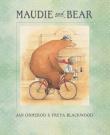 2221230638583039008.jpg
2221230638583039008.jpg
 2221230638583039008.jpg
2221230638583039008.jpg
'Maudie's world revolves around Maudie. Bear's world also revolves around Maudie—he is as patient and solid as a rock. Maudie is so confident of Bear's love she makes little effort to deserve it. Bear's remedy for loving Maudie is to love her some more.
'Jan Ormerod's minimal text and Freya Blackwood's inspired illustrations perfectly capture the intricate relationship between parent and child. This is the ultimate of reassuring stories— it shows that a parent's love is inexhaustible.' (From the publisher's website.)
This is affiliated with Dr Laurel Cohn's Picture Book Diet because it contains representations of food and/or food practices.
| Food depiction |
|
| Food types |
|
| Food practices |
|
| Gender |
|
| Signage | n/a |
| Positive/negative value | n/a |
| Food as sense of place |
|
| Setting |
|
| Food as social cohesion |
|
| Food as cultural identity |
|
| Food as character identity |
|
| Food as language | n/a |
'This chapter explores how Australian writers and illustrators in the twenty-first century depict the act of mothering in picture books for young children in relation to cooking and serving food. It draws on the idea that children’s texts can be understood as sites of cultural production and reproduction, with social conventions and ideologies embedded in their narrative representations. The analysis is based on a survey of 124 books that were shortlisted for, or won, Children’s Book Council of Australia awards between 2001 and 2013. Of the eighty-seven titles that contain food and have human or anthropomorphised characters, twenty-six (30 percent) contain textual or illustrative references to maternal figures involved in food preparation or provision. Examination of this data set reveals that there is a strong correlation between non-Anglo-Australian maternal figures and home-cooked meals, and a clear link between Anglo-Australian mothers and sugar-rich snacks. The relative paucity of depictions of ethnically unmarked mothers offering more nutritious foods is notable given the cultural expectations of mothers as caretakers of their children’s well-being. At the same time, the linking of non-Anglo-Australian mothers with home-cooked meals can be seen as a means of signifying a cultural authenticity, a closeness to the earth that is differentiated from the normalised Australian culture represented in picture books. This suggests an unintended alignment of mothers preparing and serving meals with “otherness,” which creates a distancing effect between meals that may generally be considered nutritious and the normalised self. I contend there are unexamined, and perhaps unexpected, cultural assumptions about ethnicity, motherhood, and food embedded in contemporary Australian picture books. These have the potential to inscribe a system of beliefs about gender, cultural identity, and food that contributes to readers’ understanding of the world and themselves.'
Source: Abstract.
'This chapter explores how Australian writers and illustrators in the twenty-first century depict the act of mothering in picture books for young children in relation to cooking and serving food. It draws on the idea that children’s texts can be understood as sites of cultural production and reproduction, with social conventions and ideologies embedded in their narrative representations. The analysis is based on a survey of 124 books that were shortlisted for, or won, Children’s Book Council of Australia awards between 2001 and 2013. Of the eighty-seven titles that contain food and have human or anthropomorphised characters, twenty-six (30 percent) contain textual or illustrative references to maternal figures involved in food preparation or provision. Examination of this data set reveals that there is a strong correlation between non-Anglo-Australian maternal figures and home-cooked meals, and a clear link between Anglo-Australian mothers and sugar-rich snacks. The relative paucity of depictions of ethnically unmarked mothers offering more nutritious foods is notable given the cultural expectations of mothers as caretakers of their children’s well-being. At the same time, the linking of non-Anglo-Australian mothers with home-cooked meals can be seen as a means of signifying a cultural authenticity, a closeness to the earth that is differentiated from the normalised Australian culture represented in picture books. This suggests an unintended alignment of mothers preparing and serving meals with “otherness,” which creates a distancing effect between meals that may generally be considered nutritious and the normalised self. I contend there are unexamined, and perhaps unexpected, cultural assumptions about ethnicity, motherhood, and food embedded in contemporary Australian picture books. These have the potential to inscribe a system of beliefs about gender, cultural identity, and food that contributes to readers’ understanding of the world and themselves.'
Source: Abstract.